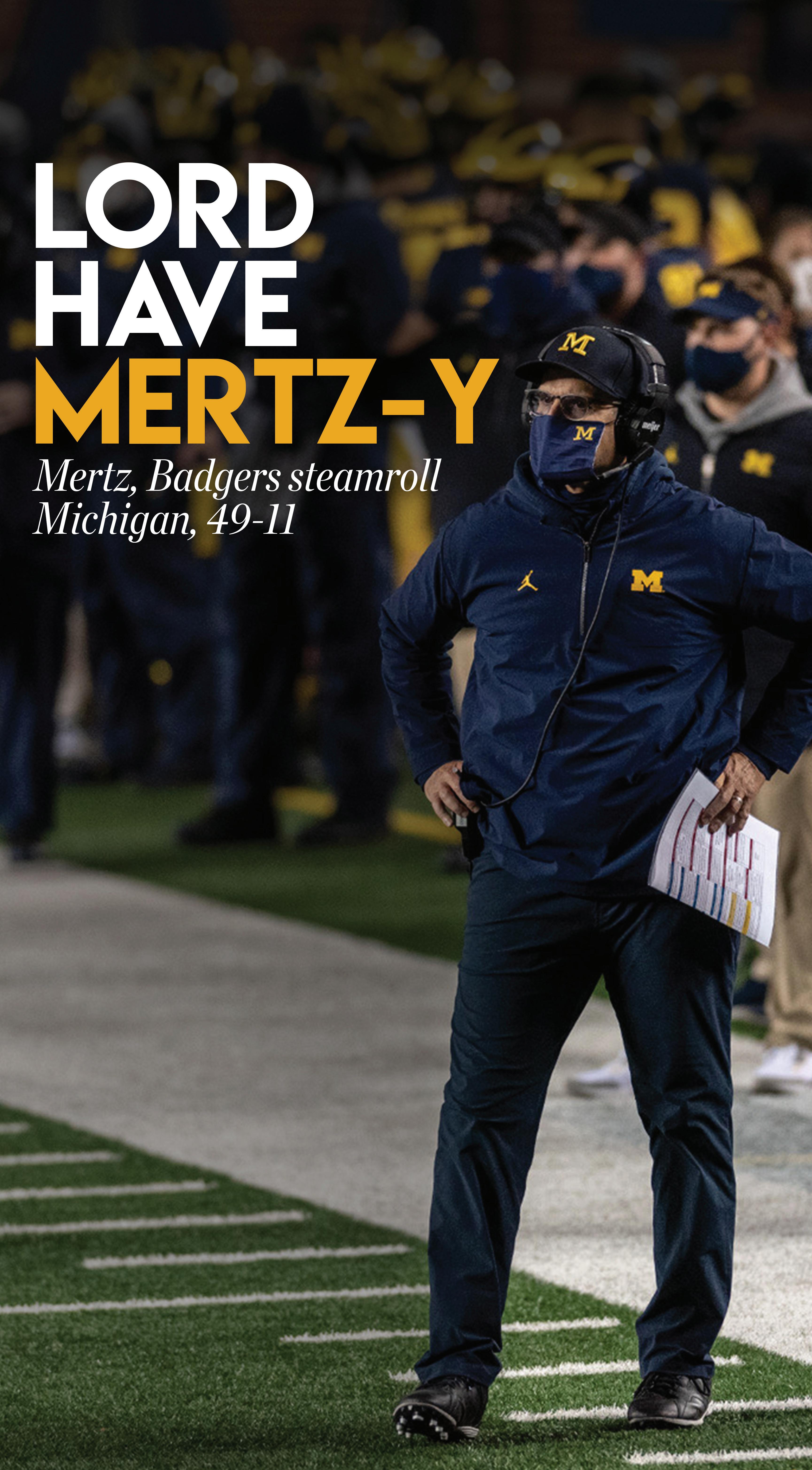Wednesday, November 18, 2020
Opinion
The Michigan Daily — michigandaily.com
EVAN STERN | COLUMN
The forgotten segment of society: rural America
M
Milwaukee and Madison carried Democrats to victory too, with Biden edging Trump by a margin of 20,000 votes. Minnesota, which voted 52.5% for Biden, tells a similar story. Outside of the Midwest, the same trend is even more apparent. Biden easily won New York’s 29 electoral votes with nearly 60% of the vote, even though the map of the Empire State has vast swaths of red. Pennsylvania, which was seen as a battleground for this presidential election, narrowly handed its 20 electoral votes over to Biden. The former vice president unsurprisingly ran the table in Philadelphia and Pittsburgh, while nearly all of the rural areas in Pennsylvania turned out in massive numbers for Trump. Finally, as this trend continues in the Midwest and Northeast, it has picked up steam in recent years in Southern and Western states, making it increasingly difficult for Republican politicians to gain traction. One of the most obvious examples of this is the state of Virginia. According to UVAToday, “Virginia in 2000 was a solid red state,” and this year, “its metro areas turned it blue for the fourth consecutive election.” While President George W. Bush picked up a comfortable 52.5% of the vote in 2000 against Democratic candidate Al Gore, Biden had a commanding lead in the same state, winning it by 54%. Now, political scientists theorize that Georgia is the next Virginia. Like Virginia, Georgia used to be a solidly red state. But the growth of the Atlanta metropolitan area has moved the state from a Republican stronghold to a tossup. While Trump won Georgia by comfortable margins in 2016, Biden just barely prevailed over Trump in 2020, garnering 49.5% of the vote. In the future, it is quite plausible that like Virginia, Georgia will be a solidly Democratic state as the population continues to shift to urban and suburban areas. Georgia isn’t the only state that is demonstrating these population shifts. For example, as Arizona’s sole urban center of Phoenix continues to enlarge, the state has moved from the Republican column in most elections to an apparent toss up. Trump also took Arizona easily in 2016 but lost to Biden by slim margins in 2020. Nevada, with the growing Las Vegas metro area, and North Carolina, with the Raleigh and Charlotte metropolitan areas, are additional clear examples of this accelerating trend. While Trump won North Carolina in 2016 with little trouble, the state was so close in 2020 that it took days to call. As the 2020 presidential election becomes a distant memory and time goes by, this trend will not only continue where it has already started, but it will also likely become more common in areas where it has not. While increased urbanization and suburbanization may be seen as very favorable to the Democratic Party, since America’s cities vote reliably Democratic, the deepening urban-rural divide creates problems on the national scale. For one, rural America continues to deal with
issaukee County, a secluded community in the northern Lower Peninsula with a population just edging 15,000, is a long way from Detroit. According to Google Maps, Missaukee County sits over 200 miles from Motor City, a distance that can be covered in about 3 hours by car. At first glance, there’s nothing extraordinary about Missaukee County. It’s just another rural community barely noticeable on a map. But dig a little deeper, and there’s something about Missaukee that stands out: It is one of the most conservative counties in the state of Michigan. According to 2020 election results, Missaukee voted 75.9% for President Donald Trump; 75.8% for Republican U.S. Senate candidate John James; and 78.6% for U.S. Rep. John Moolenaar, R-Mich. By contrast, Detroit — the largest city in Michigan and a solid blue community — voted 93.5% for former Vice President Joe Biden; 90.9% for Sen. Gary Peters, D-Mich.; and 92.3% for Rep. Brenda Lawrence, D-Mich. This vast political divide between communities like Detroit and Missaukee is a phenomenon becoming more common across the country. As urbanization continues and cities and suburbs grow rapidly, rural areas continue to lose both population and power. It is becoming increasingly normal for one or two concentrated urban areas — which usually are predominantly Democratic — to wield control over an entire state. While urban areas continue to expand, taking representation away from sparsely populated areas, our country is forgetting and neglecting rural America. In Michigan, this trend has been prominent for decades. Metro Detroit, according to the land boundaries delineated by the Detroit-Warren-Dearborn Statistical Area, has a population of 4.32 million people. This means that the greater Detroit region, which covers less than 7% of Michigan’s land area, accounts for over 43% of its population. In the November general election, the two largest counties in Metro Detroit (as well as Michigan), Wayne and Oakland, voted 68.0% and 56.2% for Biden respectively. Votes for the Democratic presidential candidate from vastly urban areas are arguably what put Biden over the top in our state, securing him Michigan’s 16 electoral votes; the same is true for Peters, who also secured Michigan by narrow margins. There is significant evidence for this phenomenon in other Midwestern states, too. Take Illinois, for instance. Illinois has a population of roughly 12.7 million, but the Chicago metropolitan area accounts for a staggering 75% of that tally, even though it takes up a miniscule 13% of Illinois’ land area. In the presidential election, Illinois voted 55.1% for Biden, even though Trump neared 80% of the vote in many of the state’s rural counties. In Wisconsin, which borders Illinois to the north, the state’s urban areas like
MAX STEINBAUM | COLUMN
RILEY DEHR | COLUMN
L
iving in a hyper-divided post-election nation, it’s easy to forget the feeling of unity that existed at the beginning of the pandemic. Whether it was rallying around our essential workers or sharing our desperate search for toilet paper, a common enemy seemed to unite us, if only for a moment. Perhaps my favorite example of this is the strangest. Throughout the spring and early summer, in Denver, where I am spending my semester, people let out their inner wolf for a minute each evening. At 8 p.m., as the sun would begin to set, a series of scattered howls would slowly rise into a cacophony that echoed through the entire city. Originally intended as a sign of support for essential workers, it slowly grew to become a community-bonding event. As we all felt the grueling effects of social isolation, calling out to each other, especially in such an unconventional way, felt like the perfect way to express frustration and solidarity during a pandemic. While this habit has since ended, the howling effect may have had a lasting effect on some Coloradans as they were casting their ballots this election. On Nov. 3, Colorado citizens voted for the reintroduction of gray wolves into their state. Proposition 114, which requires the Colorado government to reintroduce wolves into the Western Rockies by 2024, was the first successful voter-based initiative to reintroduce wolves into any U.S. state. Colorado will join the rest of the Northern Rockies states, as well as Wisconsin, Minnesota, Washington, Oregon, New Mexico, the Carolinas and Michigan to be one of the few remaining states with wolf populations.
Read more at MichiganDaily.com Evan Stern can be reached at erstern@umich.edu.
Design courtesy of Erin Shi
Oh, howl no! Before European colonization, wolves lived in every U.S. state except Hawaii. Centuries of deforestation and the carrying out of programs aimed at their total elimination pushed wolves out of every region but two slivers of northern Minnesota and Michigan by the 1930s. After being declared an endangered species in 1978, gray wolves slowly began to repopulate the Northern Great Lakes. Wolves immigrating from Canada or introduced through conservation projects expanded the gray wolf population to include the Upper Peninsula of Michigan and northern Wisconsin. With an estimated population of 4,400, about two-thirds of the U.S’s wolves now live in these three states. Nearly 700 wolves in 143 packs currently roam the Upper Peninsula of Michigan. They have so far remained in this sparsely populated section of the state, yet to resettle the Lower Peninsula. Even so, wolves have been found in the Lower Peninsula in two incidences in the past few decades — the most recent in 2015. With studies indicating that the Upper Peninsula has nearly reached the maximum number of wolves that it can sustain, the likelihood that these rare examples may one day result in the recolonization of the Lower Peninsula is increasing. If wolves were to reestablish themselves on the Lower Peninsula, researchers guess that they might end up in one of the various state parks that line the tip of the mitten. Already home to red foxes, whitetail deer and black bears, the area contains vast forested territories that the wolves would need to survive. In their absence, much of the nation
has experienced an overexpansion of deer populations and the dominance of the invasive coyote as a primary predator. Here, they would once again fulfill their role as the ecosystem’s top predators, keeping both populations in check. Despite these benefits, spending centuries teaching people to hate wolves has made convincing them to welcome wolves into their communities an expectedly daunting task. Even in Colorado, where Republicans were heavily outvoted by Democrats, Proposition 114 passed by 1.2 percentage points. Proponents of the initiative were surprised by the slim margins, expecting Denver and its liberal suburbs to push it to an overwhelming victory. It reflects people’s widespread suspicions toward an animal many of us are first introduced to as “big” and “bad.” Republican politicians have long played into these misconceived notions in order to persecute the canines. When they were briefly stripped of their endangered species classification, and the federal protection that comes with it, in 2012, Wisconsin Gov. Scott Walker seized the opportunity to drastically reduce his state’s wolf population and there was even an anti-wolf committee in the Dep. of Natural Resources. During the three hunting seasons the state carried out before a federal judge redesignated their endangered status in 2014, more than half of the state’s wolves were killed.
Read more at MichiganDaily.com Riley Dehr can be reached at rdehr@umich.edu.
We haven’t seen the last of Donald
fter the tide turned against his conquest of continental Europe, Napoleon was decisively defeated by a coalition of European powers in the spring of 1814. The French emperor was then exiled by the victors to the small island of Elba, off the western coast of Italy. As the coalition powers met to determine the postwar balance of power in Europe, Napoleon, conscious of his popularity in France, slipped out of exile, returned to Paris and, until his final defeat at Waterloo, resumed the imperial throne. When the royalist government that replaced Napoleon caught wind of the former emperor’s landing in southern France, it deployed the military to stop his march towards Paris. Near the city of Grenoble, some of the royalist soldiers encountered Napoleon’s forces. Napoleon walked up to them and ripped open his coat. “If there is one among you who wishes to kill his emperor,” Napoleon supposedly said, “here I am.” None of the soldiers fired upon him. In fact, they defected, and joined with their emperor’s forces on his march towards Paris. 206 years later and one Atlantic Ocean away, Americans contended with their own emperor. The people
have spoken, and King Donald I has been dethroned. Now that President Donald Trump will not occupy the Oval Office come Jan. 20, 2021, a civil war is coming. Not that kind of civil war, thank God — a civil war within the Republican Party. Where does the GOP leadership go from here? Do they try to smother the Trumpian populist movement, drop the lame duck president like a hot orange potato, slowly distancing themselves from a disgraced Trump, in favor of a return to establishment normalcy? Or do they still champion Trumpism, allowing the outgoing president’s movement to continue to define the party? “You know how to make America great again?” asked Sen. Lindsey Graham, R-S.C., in 2015. “Tell Donald Trump to go to hell.” Sounding like a Democrat, Graham continued by calling then-candidate Trump “a race-baiting, xenophobic, religious bigot,” and defiantly pronounced that Trump “doesn’t represent my party.” Graham, being the spineless shill that he is, later became one of Trump’s most vocal supporters in the Senate. But will he, and others in his position, now turn their backs on the president again? With Trump now trumped, what’s the expedient move?
It’s hard to predict the behavior of hypocrites like Graham, because hypocrites, being hypocrites, are unpredictable by nature. In the coming weeks, however, the rhetoric of these folks will be telling as to the direction of the Republican Party. But what will the two sides of the Republicans’ civil war be? And more importantly, who will ultimately win the soul of the GOP? My best guess is the Old Guard — the Mitch McConnell, Lindsey Graham and Kevin McCarthy types — will slowly and surely distance themselves from Trump. Not an outright rejection, but a cautious, wakeless troll in the direction of normalcy. The problem — the futility, really — with this approach is that the party’s base, its soul and core, is so hopelessly anchored to Trump that to shed the naked emperor would be to shed its identity. Once Trump became the Republican Party nominee in 2016 and the likes of Graham decided to become his loyal minions, the GOP became married to Trump. Trump’s loss in 2020 will not mean a clean divorce. In fact, it won’t even mean a separation. The New York Times’s David Brooks said it well in August 2020. Even in the event of a failed re-election, Trump will “still be the
center of everything Republican. Ambitious Republicans will have to lash themselves to the husk of the dying czar if they want to have any future in the party. The whole party will go Trump-crazed and brain dead for another four years.” With the exception of a few (and far between) principled stands against Trump’s lunacy (courtesy of John McCain, Mitt Romney and Jeff Flake), the GOP sold out to a bombastic charlatan who peddled lie upon lie upon lie for 48 straight months, and made “the greatest country on Earth” the dumpster-fire laughing stock of the world. Miraculously, Trump still remains highly popular amongst Republicans. Republican leadership — like everyone in their profession — are nothing if not self-preservational. So long as Trump remains popular with the Republican base, he’ll remain popular with the Old Guard that ultimately embraced him. The toothpaste is out of the tube; Trumpism will triumph. Biden restored the professionalism and dignity befitting of a presidential administration.
Read more at MichiganDaily.com Max Steinbaum can be reached at maxst@umich.edu.
Anti-Jewish Pogroms and the Origins of Multiculturalism
JEFFREY VEIDLINGER Joseph Brodsky Collegiate Professor of History and Judaic Studies Director, Frankel Center for Judaic Studies
Online Event: Thursday, November 19, 2020 | 4:00 p.m.
A
staggering poverty rates, which advocacy group Save the Children has called an “emergency.” In 2016, according to NPR, almost a quarter of American children growing up in rural areas were poor; meanwhile, rural areas have been plagued by a lack of quality health care options for years, a crisis exacerbated by the pandemic. Rural areas continue to be increasingly forgotten, and these regions aren’t getting the representation they deserve. More and more, conservative areas of our country are voicing their opposition to liberal power centers far away; rural Americans are tired of being left behind. In left-leaning Oregon, which voted overwhelmingly for Biden, a group of red counties successfully passed a ballot initiative to set in motion a process by which they may leave Oregon and join Idaho. In Illinois, a proposal has been discussed by conservative areas to break off from liberal Chicago. While these conversations are nothing new, they have gotten renewed attention over the course of the COVID-19 crisis, as Democratic governors set regulations for entire states, which includes red areas, to curb the spread of the coronavirus. There is no easy solution to solve this problem. It clearly sets a bad precedent to allow several counties in one state like Illinois or Oregon to secede. If that were the case, it would only be a matter of time before state boundaries in the continental U.S. looked radically different. Meanwhile, such a trend would have drastic logistical and political consequences. As the urban-rural divide continues to exert its influence more and more, some people are expressing interest in Nebraska and Maine’s congressional district method to allocate electoral votes in presidential elections. While most states, including Michigan, are winner-take-all, different presidential candidates can win different congressional districts in Nebraska and Maine. If the Electoral College were reformed to operate on the basis of congressional districts instead of entire states, it would take away much of the influence of predominantly urban areas, since rural districts in blue states would typically be won by Republican candidates. Such a change could hurt the Democratic Party in some regions, but it would help both Republicans and Democrats in obvious ways. For example, Texas, Florida and Ohio all awarded their electoral votes to Trump in the 2020 presidential election, but all three of these states have significant blue territory in urban areas. In a reformed Electoral College, while Democrats would be harmed in blue states like New York and Illinois, they would be able to acquire more electoral votes from urban centers that aren’t represented in red states.
An online lecture. For more information, visit events.umich.edu/event/75456 or call 734.615.6667.





